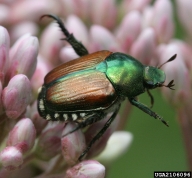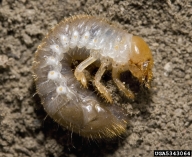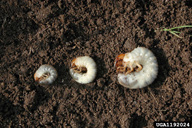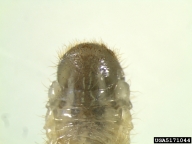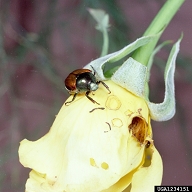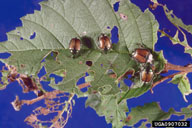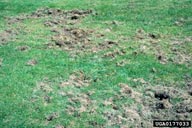Japanese beetle
Popillia japonica Newman (Coleoptera: Scarabaeidae)
Orientation to pest
The Japanese beetle, Popillia japonica Newman, is an invasive insect in North America (United States and Canada) that is native to Japan. It is also invasive in China, Russia and Portugal. Adults fly during the summer and may occur in large numbers, defoliating raspberries, strawberries, roses, grapes, and other plants. Adults burrow into the soil, especially in grassy areas, and lay eggs several inches underground, where larvae then develop, feeding on the roots of grass plants and damaging the turf. There is usually one generation per year and partly grown larvae in the soil are the overwintering stage.
Hosts commonly attacked
Adults defoliate a wide range of plants including grapes, roses, and various shade and fruit trees. Larvae eat the roots of grasses and are major pests of turf, especially on golf courses. Larvae can be pests in tree nurseries or on ornamental nursery stock.
Distribution
In North America, the Japanese beetle is found in most states east of the Mississippi River and the invaded area continues to expand. One important pathway by which this pest is spread is the movement of larvae in nursery stock shipped with soil. The beetle is not found in California or the Pacific Northwest states.
Images of Japanese beetle
| Figure 1. Adult Japanese beetle, Popillia japonica | Figure 2. Larva of the Japanese beetle (left); three species of "white grubs" (right) to show relative size, from left to right - Japanese beetle, European chafer (Rhizotrogus majalis [Razoumowsky]), and June beetle (Phyllophaga sp.). | |
| Figure 3. The V-shaped pattern of the "raster" (a group of hairs on underside of the rear tip of larval body) is used to identify larvae of Japanese beetles | ||
| Figure 4. Adult Japanese beetles feeding on rose flower (left) and foliage of other plants (right) | Figure 5. Turf, infested by Japanese beetle larvae and then dug up by skunks or other mammals to eat grubs | |
Important biological control agents related to this pest species
A large scale effort to achieve biological control of this pest, based on searching for natural enemies in Japan and China, was made in the 1920s and 1930s. Several parasitoids were imported and established, the most important of which were three tachinid flies (especially Istocheta aldrichi [Mesnil]) and several tiphiid wasps (especially Tiphia popilliavora Rohwer and Tiphia vernalis Rohwer). Several pathogens of this beetle were also discovered and attempts were made to turn them into biopesticides. These included the bacterium that causes milky spore disease (Paenibacillus popilliae [Dutky]) and the nematode Steinernema glaseri (Steiner). It was the study of this nematode that stimulated the development of this family of nematodes as successful biopesticides against soil insects. For a detailed history of the biological control efforts against Japanese beetle, see Van Driesche et al. (1996).
Web links for information on Japanese beetle
- Wikipedia Article | Wikipedia, the free encyclopedia
- Featured Creature Fact Sheet | University of Florida and FDACS
- Plant Health Publication | USDA APHIS
Articles
- Van Driesche, R. G., S. Healy, and R. C. Reardon. Biological Control of Arthropod Pests of the Northeastern and North Central Forests in the United Staets: A review and recommendations. FHTET-96-19 USDA Forest Service, Morgantown, West Virginia, see pp. 43-48. Viewable at http://www.forestpestbiocontrol.info/fact_sheets/documents/arthropodpestsnortheastern_northcentral.pdf
- Power, K. T., R. S. An, and P.S. Grewal. 2009. Effectiveness of Heterohabditis bacteriophora strain GPS11 applications targeted against different instars of the Japanese beetle Popillia japonica. Biological Control 48: 232-236.
- Oliver, J. B., M. E. Reding, N. N. Youssef, M. G. Klein, B. L. Bishop, and P. A. Lewis. 2009. Surface-applied insecticide treatments for quarantine control of Japanese beetle, Popillia japonica Newman (Coleoptera: Scarabaeidae), larvae in field-grown nursery plants. Pest Management Science 65: 381-390.
